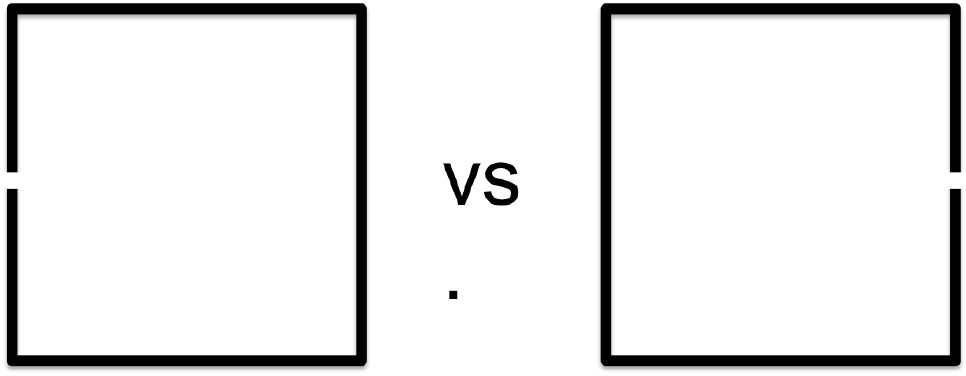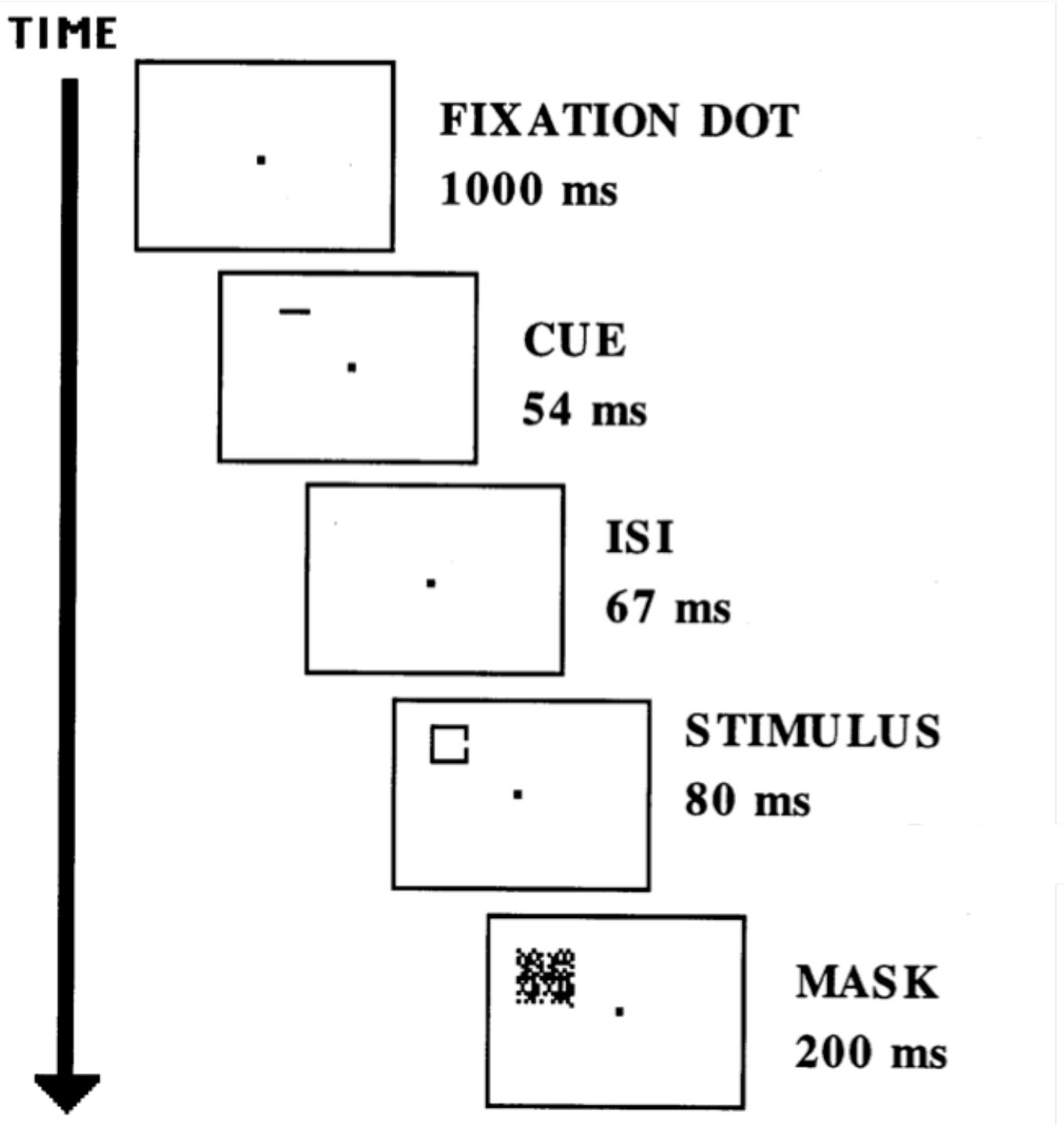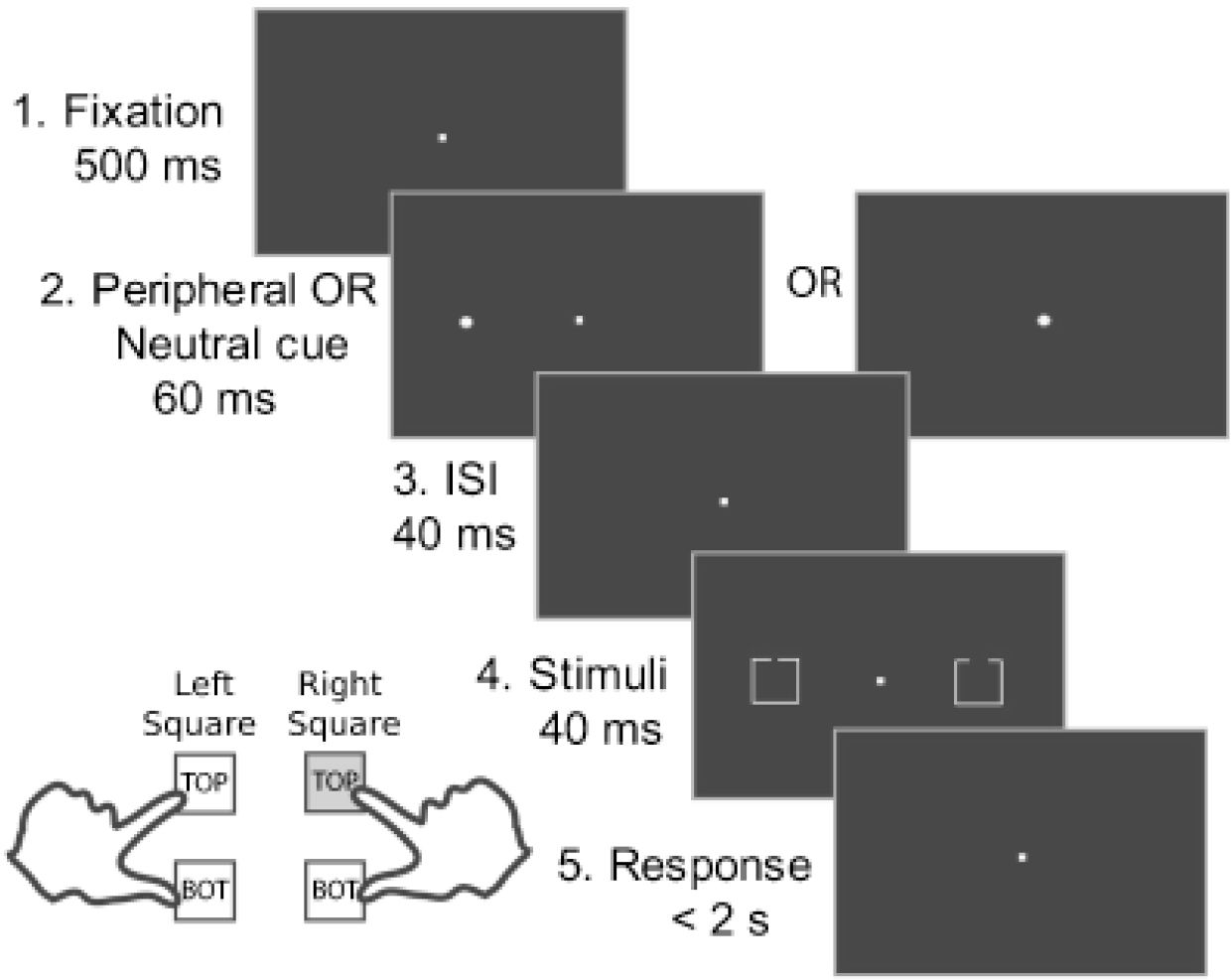4 Attention affects appearance
William James (1890, p. 404) famously said attention “… is the taking possession by the mind, in clear and vivid form, of one out of what seem several simultaneously possible objects or trains of thought. Focalization, concentration, of consciousness are of its essence. It implies withdrawal from some things in order to deal effectively with others.” Except for the exclusion of unconscious attention, most scientists would accept something like that characterization today. Spatial attention is attention directed to a portion of environmental space and is distinct from attention to an individual (e.g., a thing, a surface or a property instance) or to a property.
The mechanisms of attention are fairly well understood. Spatial attention boosts neural activation in circuits that process information from the spatial area that is attended, inhibiting activation in circuits that process information from adjacent areas. Feature-based attention boosts neural activation for attended features, inhibiting neural activation for other features. Object based attention does the analogous task for objects. Feature-based attention refines selectivity for the attended feature whereas spatial attention refines selectivity for the attended area of space (Carrasco 2011; Ling et al. 2014).
The main body of this paper is concerned with the effect of the modulation of spatial attention on phenomenology and representational content. Except when mentioned explicitly, I am talking about spatial attention rather than attention to a property instance or an object. My argument is based on experiments that indicate that attention affects appearance. To begin, attention affects perceptual acuity, one measure of which is whether one can detect whether there is a gap or what side it is on in a Landolt square. (For examples of Landolt sqaures, see Figure 4.)
 Figure 4: Landolt squares, i.e., squares with gaps. The subjects’ task in the experiment diagrammed in Figure 4 was to report (via key presses) whether the gap is on the left or on the right. The squares were presented at various locations while the subject was fixating in the middle of the screen. Redrawn from Yeshurun & Carrasco (1999).
Figure 4: Landolt squares, i.e., squares with gaps. The subjects’ task in the experiment diagrammed in Figure 4 was to report (via key presses) whether the gap is on the left or on the right. The squares were presented at various locations while the subject was fixating in the middle of the screen. Redrawn from Yeshurun & Carrasco (1999).
Yaffa Yeshurun & Marisa Carrasco (1999) asked subjects to press different keys depending on whether a Landolt square had a gap on the left or the right. The Landolt square could be presented at any of 16 different locations of 3 different eccentricities. In half of the trials, the square was preceded by a green bar presented briefly at the location in which the square would appear. Then after a pause, a Landolt square appeared in the same location as the line, and then a noise “mask” was presented to prevent an ongoing iconic representation of the stimulus. The subject was supposed to press a key indicating which side the gap was on. See Figure 5 for the sequence of presentations. (An icon would introduce an unwanted source of variability since “iconic memory” varies from person to person. A later experiment (Carrasco et al. 2002) obtained similar results without a mask.) The result is that subjects were more accurate and also faster when the cue indicated the location of the square than when there was no cue. Similar results were shown for other acuity tests, e.g., distinguishing a dotted line from a solid line.
This experiment involves “exogenous” attention in which the subject’s attention is automatically attracted by a highly visible change, e.g., a sudden motion or disappearance of an object. A similar effect has been shown when the subject is told, for example, to attend to the right when a central bar points in that direction. This is a matter of “endogenous” attention. Exogenous spatial attention is sometimes referred to as “transient” or “bottom-up” attention, whereas endogenous spatial attention is “sustained” or “top-down”. Exogenous attention is involuntary whereas endogenous attention is voluntary. Exogenous spatial attention peaks by 120 ms after the cue, whereas endogenous spatial attention requires at least 300 ms to peak and has no known upper temporal limit.
Using a similar paradigm and comparing the effects of exogenous and endogenous attention (Montagna et al. 2009), researchers showed that endogenous attention decreased the minimum size of a gap that could be detected by about 35% compared to a gap on the opposite side from the cue. That is, subjects could detect much smaller gaps when they attended to the area in which they appeared.
 Figure 5: Yeshurun & Carrasco (1999) asked subjects to fixate (point their eyes) at a dot at the center of a screen. Then a cue appeared for 54 ms, then an “interstimulus interval”, then a Landolt Square, then a mask. (See the text for the purpose of the mask.) Note that it takes 250 ms for eye movement to a new location, so in this and the other experiments described here the brief presentations of stimuli preclude eye movements to the cued items. I am grateful to Marisa Carrasco for giving me this figure.
Figure 5: Yeshurun & Carrasco (1999) asked subjects to fixate (point their eyes) at a dot at the center of a screen. Then a cue appeared for 54 ms, then an “interstimulus interval”, then a Landolt Square, then a mask. (See the text for the purpose of the mask.) Note that it takes 250 ms for eye movement to a new location, so in this and the other experiments described here the brief presentations of stimuli preclude eye movements to the cued items. I am grateful to Marisa Carrasco for giving me this figure.
The conclusion is that attention affects acuity. This is not part of the evidential basis for the argument to come. However there is another effect that is directly relevant to my argument: attention also causes the gap to be perceived as larger. This was shown by a later type of experiment from Carrasco’s lab.
 Figure 6: Experiment from Gobell & Carrasco (2005). Procedure described in text. Reproduced with permission from Psychological Science.
Figure 6: Experiment from Gobell & Carrasco (2005). Procedure described in text. Reproduced with permission from Psychological Science.
The subjects were asked to fixate on the dot that appeared for half a second (upper left in Figure 6). Then the subjects saw a dot on the left or a dot on the right or only at the fixation point in the center of the screen. Then the subjects saw two Landolt squares each of which could have a gap either on the top or the bottom (even though the figure shows the gap on the same side). The subject was then asked to report whether the bigger of the two gaps is on the top or the bottom. If the gap on the left was bigger, the subject was supposed to report the answer using the left pair of keys; mutatis mutandis if the right gap is bigger. The subject was told—correctly—that the dot did not predict anything about the size of the gaps. The subjects’ instructions focus on the top/bottom difference whereas what the experiment is really about is the perceived size. The purpose of the dot was to attract the subjects’ exogenous (involuntary) attention to one side or the other on some trials. What was being tested is whether attention to, e.g., the left, would cause the perceiver to treat the left gap as bigger. The result was that it does. Subjects did not discriminate between an attended .20o degree gap and an unattended .23o gap. (The gap sizes are measured in degrees of visual angle. If a distance between the eyes and the screen is specified, the degree coding can be changed into inches.)[10] Note that subjects were not asked to judge relative sizes of gaps. In particular they were not asked to judge whether an attended .20o degree gap and an unattended .23o gap “look the same”. Rather, the subjects were asked to make discriminations based on apparent gap size. The result is that they are indiscriminable. And this fact about these experiments has led to disputes about what they really show, as I will explain.
The experiment diagrammed in Figure 5 shows attention increases acuity. This one shows that attention makes gaps look bigger. One of the main mechanisms by which attention improves acuity is that attention shifts and shrinks receptive fields (Anton-Erxleben & Carrasco 2013). The shifting of receptive fields is probably involved in both the increase in acuity and the larger appearance. Attention to an area of space causes neurons that were not aiming at that area of space to shift towards it. The effect is more neurons covering that area of space. More neurons covering that area increases the acuity of perception of it. And this mechanism is responsible for the increase in apparent size as explained by Katharina Anton-Erxleben et al. (2007). Their explanation depends on the “labeled-line” hypothesis that neurons in the early visual system are hard wired to code for a certain area of space. So when the receptive fields of neurons shift towards a target the brain treats the size of the target as larger.